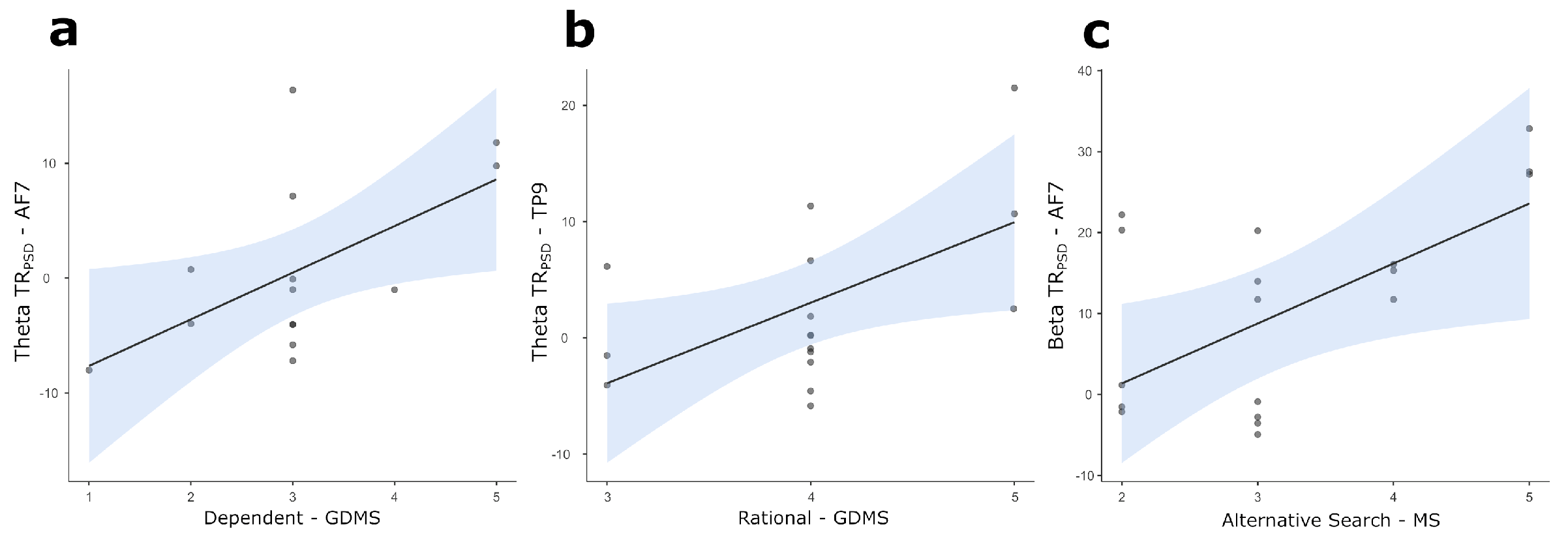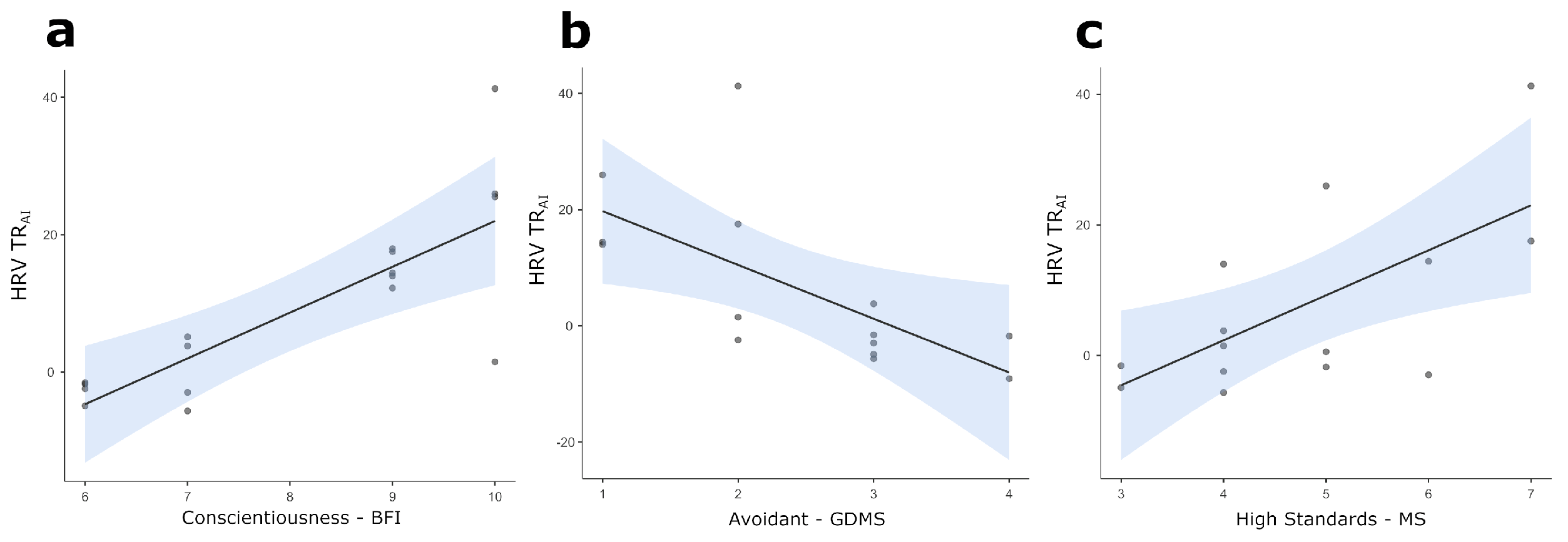Emotional and Cognitive “Route” in Decision-Making Process: The Relationship between Executive Functions, Psychophysiological Correlates, Decisional Styles, and Personality
Abstract
:1. Introduction
2. Materials and Methods
2.1. Sample
2.2. Procedure
2.2.1. Behavioural Data Acquisition
2.2.2. Electrophysiological Data Acquisition
2.2.3. Autonomic Data Acquisition
2.2.4. Self-Report Data Acquisition
2.3. Data Analyses
3. Results
3.1. Step One
3.2. Step Two
4. Discussion
Supplementary Materials
Author Contributions
Funding
Institutional Review Board Statement
Informed Consent Statement
Data Availability Statement
Conflicts of Interest
References
- Balconi, M. Why a Dynamic Multicomponential Model of Decision Making: Some Milestones and a Preliminary Tool. Neuropsychol. Trends 2023, 33, 9–16. [Google Scholar] [CrossRef]
- Butler, M.J.R.; O’Broin, H.L.R.; Lee, N.; Senior, C. How Organizational Cognitive Neuroscience Can Deepen Understanding of Managerial Decision-making: A Review of the Recent Literature and Future Directions. Int. J. Manag. Rev. 2016, 18, 542–559. [Google Scholar] [CrossRef]
- Crivelli, D.; Acconito, C.; Balconi, M. What Happens to Information, Situational Cues, and Individual Strategies in Decision-Making? The Contribution of Latent Decisional Profiles in Realistic Decisions. Decision 2024, 51, 57–68. [Google Scholar] [CrossRef]
- Balconi, M.; Angioletti, L.; Crivelli, D. Neuro-Empowerment of Executive Functions in the Workplace: The Reason Why. Front. Psychol. 2020, 11, 1519. [Google Scholar] [CrossRef] [PubMed]
- Zelazo, P.D.; Cunningham, W. Executive Function: Mechanisms Underlying Emotion Regulation. In Handbook of Emotion Regulation; Gross, J., Ed.; The Guilford Press: New York, NY, USA, 2007; pp. 135–158. [Google Scholar]
- Colautti, L.; Antonietti, A.; Iannello, P. Executive Functions in Decision Making under Ambiguity and Risk in Healthy Adults: A Scoping Review Adopting the Hot and Cold Executive Functions Perspective. Brain Sci. 2022, 12, 1335. [Google Scholar] [CrossRef] [PubMed]
- Zelazo, P.D. Executive Function: Reflection, Iterative Reprocessing, Complexity, and the Developing Brain. Dev. Rev. 2015, 38, 55–68. [Google Scholar] [CrossRef]
- Finucane, M.L.; Alhakami, A.; Slovic, P.; Johnson, S.M. The Affect Heuristic in Judgments of Risks and Benefits. J. Behav. Decis. Mak. 2000, 13, 1–17. [Google Scholar] [CrossRef]
- Slovic, P.; Peters, E.; Finucane, M.L.; MacGregor, D.G. Affect, Risk, and Decision Making. Health Psychol. 2005, 24, S35–S40. [Google Scholar] [CrossRef] [PubMed]
- Lakomski, G.; Evers, C.W. Passionate Rationalism: The Role of Emotion in Decision Making. J. Educ. Adm. 2010, 48, 438–450. [Google Scholar] [CrossRef]
- Crivelli, D.; Allegretta, R.A.; Balconi, M. Physiology of Risk-Taking and Risk Management in Realistic Decision-Making Scenarios. Psychol. Rep. 2024. Advance Online Publication. [Google Scholar] [CrossRef]
- Crivelli, D.; Allegretta, R.A.; Balconi, M. The “Status Quo Bias” in Response to External Feedback in Decision-Makers. Adapt. Hum. Behav. Physiol. 2023, 9, 426–441. [Google Scholar] [CrossRef]
- Sayegh, L.; Anthony, W.P.; Perrewé, P.L. Managerial Decision-Making under Crisis: The Role of Emotion in an Intuitive Decision Process. Hum. Resour. Manag. Rev. 2004, 14, 179–199. [Google Scholar] [CrossRef]
- Schiebener, J.; Brand, M. Decision Making under Objective Risk Conditions–a Review of Cognitive and Emotional Correlates, Strategies, Feedback Processing, and External Influences. Neuropsychol. Rev. 2015, 25, 171–198. [Google Scholar] [CrossRef] [PubMed]
- Crivelli, D.; Balconi, M. Shared Emotions, Interpersonal Syntonization, and Group Decision-Making: A Multi-Agent Perspective. Front. Neurosci. 2023, 17, 1251855. [Google Scholar] [CrossRef] [PubMed]
- Kahneman, D. Thinking, Fast and Slow; Farrar, Straus and Giroux: New York, NY, USA, 2011. [Google Scholar]
- Sanfey, A.G.; Chang, L.J. Multiple Systems in Decision Making. Ann. N. Y. Acad. Sci. 2008, 1128, 53–62. [Google Scholar] [CrossRef] [PubMed]
- Schneider, W.; Chein, J.M. Controlled & Automatic Processing: Behavior, Theory, and Biological Mechanisms. Cogn. Sci. 2003, 27, 525–559. [Google Scholar] [CrossRef]
- Balconi, M. Neuroassessment: Neurometrics for Assessment in Organizations. In Neuromanagement: Neuroscience for Organizations; Balconi, M., Ed.; Nova Science Publishers: New York, NY, USA, 2021; pp. 85–96. [Google Scholar]
- Golnar-Nik, P.; Farashi, S.; Safari, M.-S. The Application of EEG Power for the Prediction and Interpretation of Consumer Decision-Making: A Neuromarketing Study. Physiol. Behav. 2019, 207, 90–98. [Google Scholar] [CrossRef] [PubMed]
- Forte, G.; Morelli, M.; Grässler, B.; Casagrande, M. Decision Making and Heart Rate Variability: A Systematic Review. Appl. Cogn. Psychol. 2022, 36, 100–110. [Google Scholar] [CrossRef]
- Balconi, M.; Acconito, C.; Allegretta, R.A.; Crivelli, D. What Is the Relationship between Metacognition and Mental Effort in Executive Functions? The Contribution of Neurophysiology. Behav. Sci. 2023, 13, 918. [Google Scholar] [CrossRef]
- Engel, A.K.; Fries, P. Beta-Band Oscillations--Signalling the Status Quo? Curr. Opin. Neurobiol. 2010, 20, 156–165. [Google Scholar] [CrossRef]
- Cavanagh, J.F.; Frank, M.J. Frontal Theta as a Mechanism for Cognitive Control. Trends Cogn. Sci. 2014, 18, 414–421. [Google Scholar] [CrossRef] [PubMed]
- Klimesch, W.; Schack, B.; Sauseng, P. The Functional Significance of Theta and Upper Alpha Oscillations for Working Memory: A Review. Exp. Psychol. 2005, 52, 99–108. [Google Scholar] [CrossRef] [PubMed]
- Knyazev, G.G. Motivation, Emotion, and Their Inhibitory Control Mirrored in Brain Oscillations. Neurosci. Biobehav. Rev. 2007, 31, 377–395. [Google Scholar] [CrossRef] [PubMed]
- Crone, E.A.; Somsen, R.J.M.; Van Beek, B.; Van Der Molena, M.W. Heart Rate and Skin Conductance Analysis of Antecendents and Consequences of Decision Making. Psychophysiology 2004, 41, 531–540. [Google Scholar] [CrossRef] [PubMed]
- Davis, C.; Patte, K.; Tweed, S.; Curtis, C. Personality Traits Associated with Decision-Making Deficits. Pers. Individ. Differ. 2007, 42, 279–290. [Google Scholar] [CrossRef]
- Vaughan, R.S.; Edwards, E.J. Executive Function and Personality: The Moderating Role of Athletic Expertise. Pers. Individ. Differ. 2020, 161, 109973. [Google Scholar] [CrossRef]
- Gambetti, E.; Fabbri, M.; Bensi, L.; Tonetti, L. A Contribution to the Italian Validation of the General Decision-Making Style Inventory. Pers. Individ. Differ. 2008, 44, 842–852. [Google Scholar] [CrossRef]
- Fatima, S.; Khan, M.; Rosselli, M.; Ardila, A. Age, Executive Functioning, and Decision-Making Styles in Adults: A Moderated Mediation Model. Aging Neuropsychol. Cogn. 2020, 27, 338–350. [Google Scholar] [CrossRef]
- Pacini, R.; Epstein, S. The Relation of Rational and Experiential Information Processing Styles to Personality, Basic Beliefs, and the Ratio-Bias Phenomenon. J. Pers. Soc. Psychol. 1999, 76, 972–987. [Google Scholar] [CrossRef]
- Witteman, C.; van den Bercken, J.; Claes, L.; Godoy, A. Assessing Rational and Intuitive Thinking Styles. Eur. J. Psychol. Assess. 2009, 25, 39–47. [Google Scholar] [CrossRef]
- Reyna, C.; Ortiz, M.V. Psychometric Study of the Rational Experiential Inventory among Undergraduate Argentinean Students. Rev. Psicol. 2016, 34, 337–355. [Google Scholar] [CrossRef]
- Alacreu-Crespo, A.; Fuentes, M.C.; Abad-Tortosa, D.; Cano-Lopez, I.; González, E.; Serrano, M.Á. Spanish Validation of General Decision-Making Style Scale: Sex Invariance, Sex Differences and Relationships with Personality and Coping Styles. Judgm. Decis. Mak. 2019, 14, 739–751. [Google Scholar] [CrossRef]
- Wood, N.L.; Highhouse, S. Do Self-Reported Decision Styles Relate with Others’ Impressions of Decision Quality? Pers. Individ. Differ. 2014, 70, 224–228. [Google Scholar] [CrossRef]
- Shepherd, D.; Mulgrew, J.; Hautus, M.J. Exploring the Autonomic Correlates of Personality. Auton. Neurosci. 2015, 193, 127–131. [Google Scholar] [CrossRef] [PubMed]
- Korotkova, T.; Ponomarenko, A.; Monaghan, C.K.; Poulter, S.L.; Cacucci, F.; Wills, T.; Hasselmo, M.E.; Lever, C. Reconciling the Different Faces of Hippocampal Theta: The Role of Theta Oscillations in Cognitive, Emotional and Innate Behaviors. Neurosci. Biobehav. Rev. 2018, 85, 65–80. [Google Scholar] [CrossRef] [PubMed]
- Balconi, M.; Crivelli, D. Veridical and False Feedback Sensitivity and Punishment-Reward System (BIS/BAS): ERP Amplitude and Theta Frequency Band Analysis. Clin. Neurophysiol. 2010, 121, 1502–1510. [Google Scholar] [CrossRef] [PubMed]
- Bastos, A.M.; Vezoli, J.; Bosman, C.A.; Schoffelen, J.-M.; Oostenveld, R.; Dowdall, J.R.; De Weerd, P.; Kennedy, H.; Fries, P. Visual Areas Exert Feedforward and Feedback Influences through Distinct Frequency Channels. Neuron 2015, 85, 390–401. [Google Scholar] [CrossRef] [PubMed]
- Wróbel, A. Beta Activity: A Carrier for Visual Attention. Acta Neurobiol. Exp. (Wars) 2000, 60, 247–260. [Google Scholar] [CrossRef] [PubMed]
- Faul, F.; Erdfelder, E.; Buchner, A.; Lang, A.-G. Statistical Power Analyses Using G*Power 3.1: Tests for Correlation and Regression Analyses. Behav. Res. Methods 2009, 41, 1149–1160. [Google Scholar] [CrossRef]
- Stoet, G. PsyToolkit: A Software Package for Programming Psychological Experiments Using Linux. Behav. Res. Methods 2010, 42, 1096–1104. [Google Scholar] [CrossRef]
- Scott, S.G.; Bruce, R.A. Decision-Making Style: The Development and Assessment of a New Measure. Educ. Psychol. Meas. 1995, 55, 818–831. [Google Scholar] [CrossRef]
- Nenkov, G.Y.; Morrin, M.; Ward, A.; Schwartz, B.; Hulland, J. A Short Form of the Maximization Scale: Factor Structure, Reliability and Validity Studies. Judgm. Decis. Mak. 2008, 3, 371–388. [Google Scholar] [CrossRef]
- Guido, G.; Peluso, A.M.; Capestro, M.; Miglietta, M. An Italian Version of the 10-Item Big Five Inventory: An Application to Hedonic and Utilitarian Shopping Values. Pers. Individ. Differ. 2015, 76, 135–140. [Google Scholar] [CrossRef]
- Giovannini, C.; Giromini, L.; Bonalume, L.; Tagini, A.; Lang, M.; Amadei, G. The Italian Five Facet Mindfulness Questionnaire: A Contribution to Its Validity and Reliability. J. Psychopathol. Behav. Assess. 2014, 36, 415–423. [Google Scholar] [CrossRef]
- Hair, J.F.; Black, W.C.; Babin, B.J.; Anderson, R.E. Multivariate Data Analysis, 7th ed.; Pearson: London, UK, 2013. [Google Scholar]
- Byrne, B.M. Structural Equation Modeling with AMOS. Basic Concepts, Applications, and Programming; Routledge: London, UK, 2016; ISBN 9781315757421. [Google Scholar]
- Benjamini, Y.; Hochberg, Y. Controlling the False Discovery Rate: A Practical and Powerful Approach to Multiple Testing. J. R. Stat. Soc. B 1995, 57, 289–300. [Google Scholar] [CrossRef]
- Cumberland-Li, A.; Eisenberg, N.; Reiser, M. Relations of Young Children’s Agreeableness and Resiliency to Effortful Control and Impulsivity. Soc. Dev. 2004, 13, 193–212. [Google Scholar] [CrossRef]
- Billeke, P.; Zamorano, F.; López, T.; Rodriguez, C.; Cosmelli, D.; Aboitiz, F. Someone Has to Give in: Theta Oscillations Correlate with Adaptive Behavior in Social Bargaining. Soc. Cogn. Affect. Neurosci. 2014, 9, 2041–2048. [Google Scholar] [CrossRef] [PubMed]
- Seymour, R.A.; Wang, H.; Rippon, G.; Kessler, K. Oscillatory Networks of High-Level Mental Alignment: A Perspective-Taking MEG Study. Neuroimage 2018, 177, 98–107. [Google Scholar] [CrossRef]
- Gooding-Williams, G.; Wang, H.; Kessler, K. THETA-Rhythm Makes the World Go Round: Dissociative Effects of TMS Theta versus Alpha Entrainment of Right PTPJ on Embodied Perspective Transformations. Brain Topogr. 2017, 30, 561–564. [Google Scholar] [CrossRef]
- Wang, H.; Callaghan, E.; Gooding-Williams, G.; McAllister, C.; Kessler, K. Rhythm Makes the World Go Round: An MEG-TMS Study on the Role of Right TPJ Theta Oscillations in Embodied Perspective Taking. Cortex 2016, 75, 68–81. [Google Scholar] [CrossRef]
- Thunholm, P. Decision-Making Style: Habit, Style or Both? Pers. Individ. Differ. 2004, 36, 931–944. [Google Scholar] [CrossRef]
- Berntson, G.G.; Quigley, K.S.; Lozano, D. Cardiovascular Psychophysiology. In Handbook of Psychophysiology; Cacioppo, J.T., Tassinary, L.G., Berntson, G.G., Eds.; Cambridge University Press: New York, NY, USA, 2007; pp. 182–210. [Google Scholar]
- Thayer, J.F.; Åhs, F.; Fredrikson, M.; Sollers, J.J.; Wager, T.D. A Meta-Analysis of Heart Rate Variability and Neuroimaging Studies: Implications for Heart Rate Variability as a Marker of Stress and Health. Neurosci. Biobehav. Rev. 2012, 36, 747–756. [Google Scholar] [CrossRef] [PubMed]
- Berntson, G.G.; Bigger, J.T.; Eckberg, D.L.; Grossman, P.; Kaufmann, P.G.; Malik, M.; Nagaraja, H.N.; Porges, S.W.; Saul, J.P.; Stone, P.H.; et al. Heart Rate Variability: Origins, Methods, and Interpretive Caveats. Psychophysiology 1997, 34, 623–648. [Google Scholar] [CrossRef] [PubMed]



Disclaimer/Publisher’s Note: The statements, opinions and data contained in all publications are solely those of the individual author(s) and contributor(s) and not of MDPI and/or the editor(s). MDPI and/or the editor(s) disclaim responsibility for any injury to people or property resulting from any ideas, methods, instructions or products referred to in the content. |
© 2024 by the authors. Licensee MDPI, Basel, Switzerland. This article is an open access article distributed under the terms and conditions of the Creative Commons Attribution (CC BY) license (https://creativecommons.org/licenses/by/4.0/).
Share and Cite
Crivelli, D.; Acconito, C.; Balconi, M. Emotional and Cognitive “Route” in Decision-Making Process: The Relationship between Executive Functions, Psychophysiological Correlates, Decisional Styles, and Personality. Brain Sci. 2024, 14, 734. https://doi.org/10.3390/brainsci14070734
Crivelli D, Acconito C, Balconi M. Emotional and Cognitive “Route” in Decision-Making Process: The Relationship between Executive Functions, Psychophysiological Correlates, Decisional Styles, and Personality. Brain Sciences. 2024; 14(7):734. https://doi.org/10.3390/brainsci14070734
Chicago/Turabian StyleCrivelli, Davide, Carlotta Acconito, and Michela Balconi. 2024. "Emotional and Cognitive “Route” in Decision-Making Process: The Relationship between Executive Functions, Psychophysiological Correlates, Decisional Styles, and Personality" Brain Sciences 14, no. 7: 734. https://doi.org/10.3390/brainsci14070734




